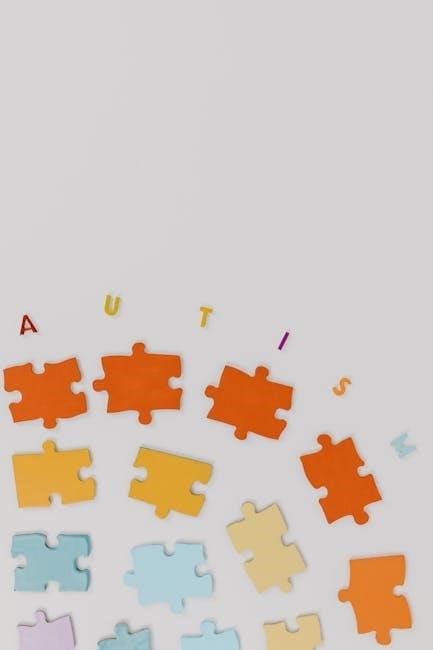Special instruction therapy involves personalized approaches to address diverse learning and developmental needs, integrating psychological, educational, and therapeutic techniques to foster growth and independence in individuals.
Definition and Scope
Special instruction therapy refers to tailored interventions designed to meet the unique needs of individuals, particularly those with learning, developmental, or emotional challenges. It integrates psychological, educational, and therapeutic strategies to promote academic, social, and emotional growth. The scope encompasses a wide range of techniques, from behavioral and cognitive approaches to occupational therapy, aiming to enhance independence and overall well-being. This therapy is often delivered by trained professionals in educational or clinical settings, adapting to individual circumstances and goals. Its versatility allows it to address diverse needs, making it a comprehensive support system for personalized development.
Historical Development
Special instruction therapy has evolved over decades, originating from early 20th-century educational reforms focusing on individualized learning. The 1950s and 1960s saw the integration of psychological theories, while the 1970s brought legal mandates for special education, expanding its reach. Advances in neuroscience and technology during the 21st century have refined techniques, emphasizing holistic approaches. This therapy has grown from isolated educational practices to a multidisciplinary field, addressing diverse needs and fostering inclusive learning environments. Its development reflects societal shifts toward valuing diversity and promoting equitable opportunities for all learners.
Types of Special Instruction Therapy
Special instruction therapy includes behavioral, cognitive, and occupational approaches, each tailored to address specific needs, fostering skills and adaptation through structured, evidence-based methodologies and individualized plans.
Behavioral Therapy
Behavioral therapy focuses on identifying and modifying negative or harmful behaviors through systematic observation and reinforcement techniques. It emphasizes learning new skills and habits to replace maladaptive ones; By understanding the relationship between behavior and its consequences, individuals can develop healthier patterns. This approach is often used in educational settings to improve academic performance and social interactions. Techniques may include positive reinforcement, token economies, and desensitization, all aimed at creating lasting behavioral change and emotional well-being.
Cognitive Therapy
Cognitive therapy focuses on identifying and challenging negative thought patterns to improve emotional and behavioral responses. It helps individuals recognize how their thoughts influence feelings and actions, promoting healthier ways of thinking. Techniques include cognitive restructuring, guided discovery, and problem-solving. This approach is effective in addressing issues like anxiety, depression, and learning difficulties. By fostering self-awareness and adaptive thinking, cognitive therapy empowers individuals to manage challenges more effectively, enhancing their overall well-being and academic performance.
Occupational Therapy
Occupational therapy helps individuals develop skills for daily activities, enhancing independence and participation in meaningful tasks. It addresses sensory, motor, and cognitive challenges, often through tailored exercises and adaptive tools. This therapy is particularly effective in educational settings, aiding students with physical or developmental disabilities to improve dexterity, focus, and coordination. By fostering practical life skills, occupational therapy supports academic performance and social interactions, enabling individuals to thrive in various environments. It plays a crucial role in special instruction, promoting holistic development and self-care routines.
Benefits of Special Instruction Therapy
Special instruction therapy enhances daily functioning, skill development, and confidence, offering tailored support to address unique challenges and foster personal growth in individuals of all abilities.
Academic Benefits
Special instruction therapy significantly enhances academic performance by providing tailored strategies to address learning challenges. It helps students with diverse needs, such as ADHD or autism, improve focus, organization, and problem-solving skills. Through personalized learning plans, therapy fosters a stronger foundation in core subjects like reading, writing, and math. This targeted support boosts confidence, encourages independent learning, and equips students with tools to overcome academic obstacles, leading to better grades and long-term educational success.
Social Benefits
Special instruction therapy fosters significant social growth by teaching communication skills, empathy, and relationship-building strategies. It helps individuals navigate group dynamics, reduce social anxiety, and develop mutual respect for others. Through structured activities, therapy encourages collaboration, active listening, and conflict resolution. This support enhances self-esteem, promotes inclusivity, and helps individuals form meaningful connections. By addressing social challenges, therapy equips individuals with the confidence to interact effectively in various settings, leading to stronger, more supportive relationships and a greater sense of community belonging.
Emotional Benefits
Special instruction therapy provides emotional support, helping individuals manage anxiety, stress, and emotional dysregulation. It fosters self-awareness, self-acceptance, and resilience, enabling individuals to cope with challenges effectively. Therapy encourages emotional expression, validation, and regulation, promoting mental well-being. By addressing emotional barriers, it enhances confidence, optimism, and overall life satisfaction. These emotional gains create a stable foundation for personal growth, ensuring individuals can navigate life’s complexities with greater emotional intelligence and stability.

Role of Parents and Educators
Parents and educators play a vital role in supporting special instruction therapy by collaborating with therapists, providing consistent support, and creating inclusive environments for optimal development and growth.
Collaboration in Therapy
Collaboration between parents, educators, and therapists is essential for effective special instruction therapy. Open communication ensures aligned goals and consistent support, fostering a cohesive environment for the individual’s progress. Regular meetings and shared feedback help tailor strategies, addressing specific needs and celebrating milestones. This collective effort enhances the therapy’s impact, providing a strong support system and promoting meaningful development. Collaboration not only strengthens relationships but also empowers individuals to thrive in various settings, making it a cornerstone of successful special instruction therapy.
Support Strategies
Effective support strategies in special instruction therapy involve creating personalized plans tailored to individual needs. Positive reinforcement, adaptive tools, and consistent routines are key. Parents and educators can use visual aids, sensory integration techniques, and communication tools to enhance learning. Incorporating real-world applications fosters practical skill development. Cultural sensitivity ensures approaches respect diverse backgrounds. Regular feedback and progress monitoring help refine strategies. By combining these methods, support strategies empower individuals to overcome challenges and achieve their full potential in a supportive and inclusive environment.

Choosing the Right Therapy
Choosing the right therapy involves assessing individual needs, goals, and preferences, ensuring alignment with evidence-based practices and cultural sensitivity for optimal outcomes and personal growth.
Evaluation Process
The evaluation process in special instruction therapy involves assessing individual needs, goals, and preferences through systematic reviews, data collection, and evidence-based practices; Professionals conduct thorough assessments, incorporating observations, interviews, and standardized tools to identify suitable interventions. Collaboration with multidisciplinary teams ensures comprehensive evaluations, aligning therapies with individual requirements. Regular progress monitoring and adjustments are made to optimize outcomes, ensuring the chosen therapy effectively addresses the person’s unique circumstances and promotes meaningful growth.
Decision-Making Factors
Decision-making in special instruction therapy involves evaluating individual needs, evidence-based practices, and therapeutic alignment. Factors include the individual’s specific goals, the therapist’s expertise, and the suitability of the therapy type. Cost, accessibility, and cultural fit also play a role. Personal preferences and the integration of multidisciplinary input are crucial. The effectiveness of the therapy, as supported by research, is a key consideration. Ultimately, decisions are tailored to maximize outcomes and ensure a personalized approach to meet unique requirements and promote lasting benefits.

Challenges and Limitations
Special instruction therapy faces challenges like limited resources, access to trained professionals, and cultural barriers, which can hinder its effective implementation and accessibility for diverse populations.
Common Obstacles
Special instruction therapy often encounters obstacles such as limited access to trained professionals, cultural or language barriers, and insufficient funding. Additionally, resistance to therapy from individuals or families, lack of awareness about its benefits, and inconsistent implementation of therapeutic strategies can hinder progress. These challenges highlight the need for systemic changes and increased support to ensure effective and equitable delivery of special instruction therapy programs. Addressing these obstacles requires collaboration among stakeholders to create inclusive and sustainable solutions.
Overcoming Strategies
To address challenges in special instruction therapy, strategies include increasing awareness through education and advocacy, enhancing training for professionals, and leveraging technology for remote access. Building strong support networks involving families, educators, and communities also fosters resilience. Additionally, adopting culturally sensitive approaches and securing sustainable funding can ensure more equitable access to therapy. By implementing these strategies, the barriers to effective special instruction therapy can be significantly reduced, promoting better outcomes for individuals in need.
Therapy Tools and Resources
Adaptive materials, assistive technologies, and specialized software are essential tools in special instruction therapy, enhancing engagement and progress for individuals with diverse learning needs and abilities.
Effective Materials
Effective materials in special instruction therapy include adaptive tools like tactile aids, visual schedules, and interactive learning kits. These resources are designed to meet individual needs, fostering engagement and skill development. They often incorporate multisensory approaches, making learning accessible for diverse learners. Assistive technologies, such as communication devices and educational software, also play a crucial role. These materials are tailored to promote independence, confidence, and academic progress, ensuring therapy sessions are both productive and meaningful for individuals with varying abilities and learning styles.
Technological Aids
Technological aids in special instruction therapy have revolutionized the way interventions are delivered. Tools like AI-driven platforms, interactive learning software, and communication devices enable personalized and engaging experiences. These aids facilitate skill development, improve accessibility, and enhance therapy outcomes. They also support remote learning and therapy sessions, ensuring continuity of care. By leveraging technology, therapists can tailor interventions to meet individual needs, making therapy more effective and inclusive for diverse learners. These advancements continue to shape modern therapeutic practices, offering innovative solutions to traditional challenges.

Success Stories and Case Studies
Documented cases highlight individuals achieving remarkable progress through special instruction therapy, showcasing transformative outcomes and inspiring hope for those navigating similar challenges.
Real-Life Examples
A young student with autism, through tailored behavioral therapy, improved social interactions and emotional regulation. Another individual with physical disabilities gained independence using adaptive tools from occupational therapy. These examples illustrate how special instruction therapy can lead to significant, life-changing outcomes when personalized and implemented effectively. By addressing unique needs, such therapies empower individuals to overcome challenges and achieve their full potential in various aspects of life.
Lessons Learned
Consistent collaboration between therapists, educators, and families is crucial for successful outcomes in special instruction therapy. Personalized approaches yield better results than one-size-fits-all methods. Early intervention and regular assessment enhance progress tracking and adaptability. Additionally, integrating technology and evidence-based practices ensures effective and engaging therapy sessions. These insights highlight the importance of adaptability and a multi-disciplinary approach in addressing diverse needs and fostering long-term development in individuals undergoing special instruction therapy.

Future Trends in Special Instruction Therapy
Future trends include integrating AI, telehealth, and personalized learning tools to enhance accessibility and effectiveness, ensuring tailored support for diverse needs and fostering inclusivity.
Emerging Techniques
Emerging techniques in special instruction therapy include AI-driven personalized learning platforms, telehealth delivery models, and immersive technologies like VR/AR for simulated learning environments. These methods enhance engagement, accessibility, and inclusivity, catering to diverse needs. Gamification and real-time data analytics are also being integrated to track progress and tailor interventions effectively. These innovations aim to create dynamic, adaptive, and student-centered approaches, ensuring therapy is more impactful and reachable for all individuals, regardless of their location or abilities.
Technological Advancements
Technological advancements are revolutionizing special instruction therapy, with generative AI and digital tools enabling personalized, data-driven interventions. ChatGPT and similar platforms now offer tailored therapeutic responses, while telehealth expands access to remote therapy. These innovations enhance engagement and efficiency, allowing therapists to adapt methods to individual needs. AI also aids in monitoring progress and providing real-time feedback. Such advancements ensure therapy is more accessible, effective, and aligned with modern learning and developmental requirements, fostering inclusivity and improved outcomes for diverse populations.

Cultural and Individual Considerations
Cultural and individual considerations in special instruction therapy emphasize respecting diverse backgrounds, beliefs, and values while tailoring approaches to meet each individual’s unique needs.
Cultural Sensitivity
Cultural sensitivity in special instruction therapy is crucial for creating inclusive and effective support systems. Therapists must understand and respect diverse cultural norms, values, and beliefs to tailor interventions appropriately. This involves adapting communication styles, incorporating cultural references, and addressing specific needs unique to each individual’s background. Collaboration with families and caregivers is essential to ensure alignment with cultural practices. By fostering a culturally sensitive environment, therapy becomes more relatable and meaningful, promoting trust and engagement. This approach ensures that interventions are both effective and respectful of the individual’s heritage. Cultural sensitivity enhances therapy outcomes significantly.
Individualized Approaches
Individualized approaches in special instruction therapy prioritize tailored interventions to meet each person’s unique needs and goals. This method ensures that therapy is adaptive, respecting the individual’s learning style, abilities, and background. Personalized plans are developed through thorough assessments and ongoing feedback, fostering a collaborative relationship between the therapist and the individual. By focusing on specific strengths and challenges, individualized approaches maximize progress and empowerment. This customized strategy ensures that therapy is both effective and meaningful, addressing the distinct requirements of each participant and promoting holistic development;

Legal and Ethical Considerations
Legal and ethical considerations in special instruction therapy ensure compliance with regulations, safeguarding confidentiality, and maintaining informed consent, upholding professional standards and client rights.
Regulatory Frameworks
Regulatory frameworks for special instruction therapy ensure adherence to laws and policies governing therapeutic practices. These frameworks, often established by national or international bodies, outline standards for licensure, confidentiality, and ethical conduct. They also mandate continuing education for professionals to stay updated on evidence-based practices. Compliance with these regulations ensures that therapies are delivered safely and effectively, protecting both clients and practitioners. Regulatory bodies may include health ministries, educational departments, or professional associations, each playing a role in maintaining quality and accountability in the field of special instruction therapy.
Ethical Practices
Ethical practices in special instruction therapy emphasize confidentiality, informed consent, and respect for individual rights. Therapists must prioritize client well-being, avoiding harm and ensuring beneficence. Professional boundaries are crucial to maintain trust and integrity. Ethical guidelines also require cultural sensitivity, adapting therapies to diverse backgrounds and needs. Continuous training and self-reflection help therapists uphold these standards, ensuring equitable and dignified care. Adherence to ethical practices fosters a safe and supportive environment, honoring individual dignity and promoting positive outcomes in special instruction therapy.
